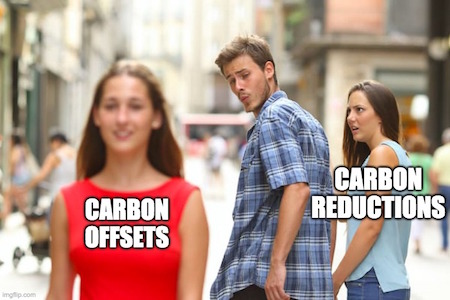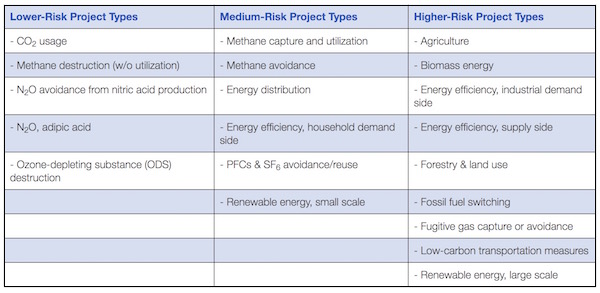I do this even though there are problems with carbon offsets. I’ve written about them before, but here are some examples:
1. You buy offsets in a project that is protecting a forest from logging. The forest burns down. This is a problem with “permanence”.
2. The forest doesn’t burn down, but the forests next to it, the unprotected forests, see extra logging. This is a problem with “leakage”.
3. You buy offsets in a project that is building a wind farm. The wind farm is in fact profitable so would have been built anyway. This is a problem with “additionality”.
4. You buy offsets in a project that is flaring methane leaks. The facility starts leaking more methane so they can earn more offset money by flaring. This is a problem with a “perverse incentive”.
5. You buy offsets in a project that is putting more efficient cookstoves in homes. But people end up returning to their familiar open-pit cooking area and no one notices. This is a problem with “verification”.
Critics say carbon offsets are an unfortunate distraction from the work we should be doing.

As you can imagine, organizations that qualify and recommend offset projects are familiar with these objections and try to correct for them, for example by:
1. Independently verifying CO2 reductions of the changes they are making.
2. Tracking projects over an extended period of time.
3. Buffering their offset pool to account for problems (e.g., forest fires).
4. Ensuring that the local community finds a meaningful win in the new system, to increase permanence. For example, maybe odor is eliminated by implementing a new waste composting system.
5. Developing co-benefits beyond carbon emissions, such as enhanced animal habitat. These qualitative wins can soften problems with unavoidable uncertainties in offset calculations.
But despite these efforts, there are no perfect offsets. The Stockholm Environment Institute publishes a comprehensive guide to offsets, including the list on the left of the types that tend to be lower risk.

Let’s consider a “lower-risk” project, namely destroying refrigerants, which have an outsized impact on global warming in addition to depleting ozone. We handle these very carefully in the United States, but not all countries do. Offset provider Tradewater’s mission is to collect these substances in countries with no policy and carefully destroy them. Sounds good, and it’s what I bought this year.
But it’s hardly perfect. My offsets happened to come from a project in Ghana. What if the effect of this work is that Ghana decides not to pass its own “cleanup” policy for refrigerants because it’s cheaper and more convenient to have high-minded foreigners come in and do the cleanup for them? Are we really saving the day or just moving the problem around? Even the best offsets can have dampening effects on emissions reductions.
The thing is, few of us are zeroing out our emissions immediately. Maybe we are waiting a few years for a cheaper EV or more people who can install heat pumps. Or maybe it’s proving hard to change our diet. Offsets can mitigate the impact of emissions that are taking time for us to reduce. In the context of climate change, I am for anything that buys us more time. (1)
For example, I like cookstove projects. Stockholm sees those as “medium risk”. But when done properly they change how families cook, reducing emissions while providing other important benefits.

Testimonials from a Cool Effect cookstove offset project in Honduras
To reduce the risk of these offsets, good organizations will ensure the new stove is a fixture in the house (e.g., brick and mortar), and that it is the only stove in the house. They will come back periodically to make sure it’s working and being used. Over time, as the family appreciates the cleaner air in the house, the faster cooking time, and the reduced cost of the fuel, it becomes something they won’t go back from. The project accelerates a cultural change away from inefficient and unhealthy open-fire cooking. The new generation becomes familiar with cooking on a stove, and will find it easier to move to clean-powered electric stoves when they become available.

Information about a cookstove offset project in Mexico
Waste management practices, such as with methane capture or composting, can also work in the same way, melding emissions reduction with a cultural change. So can forestry management. With a good set of co-benefits and local buy-in, these offsets bring about near-term, long-lasting improvements for people and the planet.

Testimonials from a Cool Effect methane capture offset project in China
Quality projects come with ample (and I do mean ample) documentation, describing both the opportunities and the challenges of the projects. Here is the documentation for the project in Ghana that I funded this year, to destroy refrigerants. Multi-dimensional projects that are embedded in communities, like this award-winning preservation project in Zambia that I funded last year, have even more documentation. Still, it can be hard to know what is reliable. Even the Nature Conservancy has been criticized for selling meaningless offsets.
My advice: If you are interested in offsetting your emissions, don’t aim for perfection. Find a project that you like, that meets reputable standards, that makes sense to you, that you think can reduce emissions and do some good. Then take a guess at your household emissions for the year (probably between 10-40 tons per person) and make a contribution. There are good projects out there that are doing some good. Offsetting should not be mistaken for absolution. It’s more like a charitable donation to the Earth, a way of buying some time for your harder-to-reduce emissions. (2)
There’s a reason this is not my last post of the year. The emissions reductions work that only we can do happens in our own households. So I will end the year with a post about creating new habits that lower our own emissions. Emissions reductions made now have a much bigger impact than emissions reductions made later, so we all need to get moving on what we can do in our own homes, some of which is really easy. I’m excited to share next week some of my own successes and not-so-successes from this past year, and thoughts on next year.
Notes and References
1. In fact some researchers have been looking at incorporating time into the value of offsets, as you can see in this estimation tool. My guess is that the discount rate is pretty big, making the shorter-term offsets a relatively good value, at least for purposes like mine.
2. One of the difficulties with carbon offsets is that they are very often used by companies to negate carbon emissions in order to meet pledges they have made to reduce their emissions. Offsets are specifically designed to meet that standard, but there are numerous ways they can fall short. Because of that, the use of offsets is often restricted to a small portion of any pledged emissions reductions. California’s cap-and-trade system tightened up on offsets a few years ago: “The offset usage limit will decrease to 4% (from 8%) for 2021-2025 emissions, and then increase to 6% for 2026-2030 emissions. Starting with 2021 emissions, no more than one-half of the quantitative offset usage limit may be sourced from projects that do not provide direct environmental benefits in California. Offset credits must be real, additional, permanent, verifiable, quantifiable, and enforceable.” United Airlines recently announced that it will be switching its focus from carbon offsets to removing carbon from the atmosphere. CNBC quotes its CEO as saying: “(Offsetting) may feel good in the short term but the math just doesn’t come close to adding up.”
Household donations imo are different, in part because they are not material to a contract, they are smaller in scale, and they can reflect personal values beyond emissions reductions. But carbon removal is available for those households that want to splurge for it.
3. I’ve often wondered why there aren’t carbon offsets for energy efficiency projects, where you could provide capital for insulating homes and similar. I think it’s related to energy efficiency being profitable over time and so not qualifying for offsets. Interestingly, Steve Wozniak and others have developed a cryptocurrency designed to fund energy efficiency, where the investors (currency holders) would receive some of the returns. I do not understand all of it, but it’s an interesting alternative to offsets…
Current Climate Data (October/November 2020)
Global impacts, US impacts, CO2 metric, Climate dashboard (updated annually)
The world had its warmest November ever this year. “According to Copernicus scientists, global average temperatures during November were 1.4 degrees (0.77 Celsius) above 1981-2010 levels, beating the previous warmest November by a large margin.”
Comment Guidelines
I hope that your contributions will be an important part of this blog. To keep the discussion productive, please adhere to these guidelines or your comment may be moderated:
- Avoid disrespectful, disparaging, snide, angry, or ad hominem comments.
- Stay fact-based and refer to reputable sources.
- Stay on topic.
- In general, maintain this as a welcoming space for all readers.



